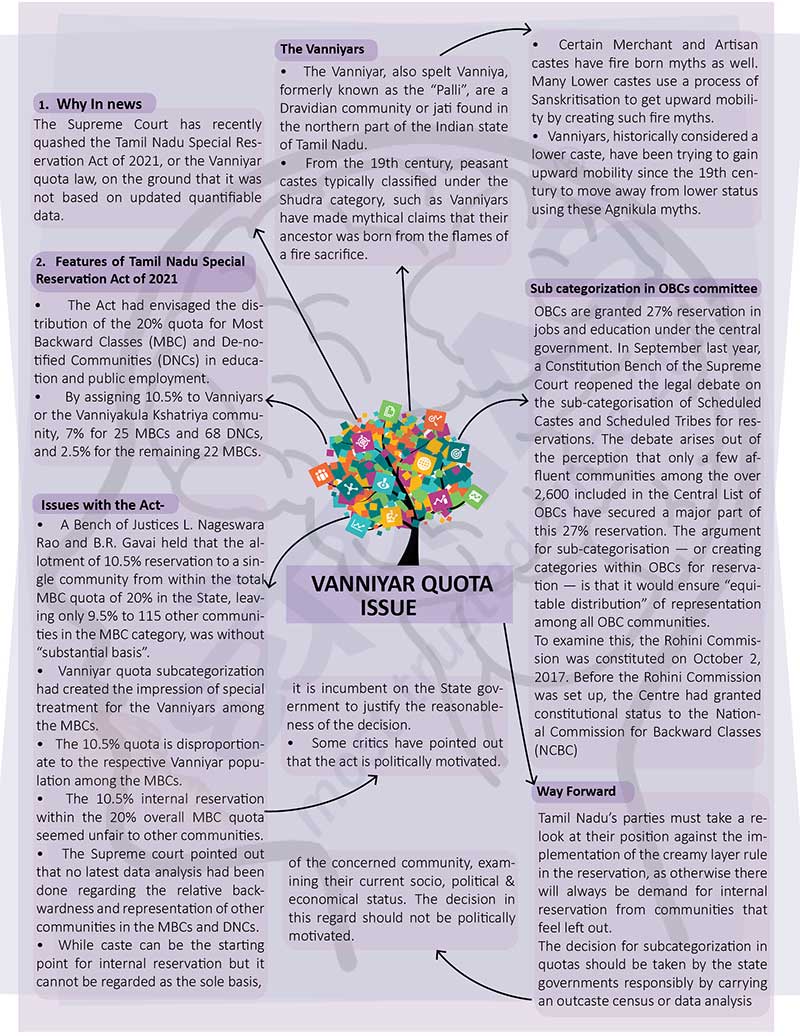Brain-booster
/
21 Apr 2022
Brain Booster for UPSC & State PCS Examination (Topic: Vanniyar Quota Issue)

Why in news?
- The Supreme Court has recently quashed the Tamil Nadu Special
Reservation Act of 2021, or the Vanniyar quota law, on the ground that it
was not based on updated quantifiable data.
Features of Tamil Nadu Special Reservation Act of 2021
- The Act had envisaged the distribution of the 20% quota for Most
Backward Classes (MBC) and De-notified Communities (DNCs) in education and
public employment.
- By assigning 10.5% to Vanniyars or the Vanniyakula Kshatriya community,
7% for 25 MBCs and 68 DNCs, and 2.5% for the remaining 22 MBCs.
Issues with the Act:
- A Bench of Justices L. Nageswara Rao and B.R. Gavai held that the
allotment of 10.5% reservation to a single community from within the total
MBC quota of 20% in the State, leaving only 9.5% to 115 other communities in
the MBC category, was without “substantial basis”.
- Vanniyar quota subcategorization had created the impression of special
treatment for the Vanniyars among the MBCs.
- The 10.5% quota is disproportionate to the respective Vanniyar
population among the MBCs.
- The 10.5% internal reservation within the 20% overall MBC quota seemed
unfair to other communities.
- The Supreme court pointed out that no latest data analysis had been done
regarding the relative backwardness and representation of other communities
in the MBCs and DNCs.
- While caste can be the starting point for internal reservation but it
cannot be regarded as the sole basis, it is incumbent on the State
government to justify the reasonableness of the decision.
- Some critics have pointed out that the act is politically motivated.
The Vanniyars
- The Vanniyar, also spelt Vanniya, formerly known as the “Palli”, are a
Dravidian community or jati found in the northern part of the Indian state
of Tamil Nadu.
- From the 19th century, peasant castes typically classified under the
Shudra category, such as Vanniyars have made mythical claims that their
ancestor was born from the flames of a fire sacrifice.
- Certain Merchant and Artisan castes have fire born myths as well. Many
Lower castes use a process of Sanskritisation to get upward mobility by
creating such fire myths.
- Vanniyars, historically considered a lower caste, have been trying to
gain upward mobility since the 19th century to move away from lower status
using these Agnikula myths.
Sub categorization in OBCs committee
- OBCs are granted 27% reservation in jobs and education under the central
government. In September last year, a Constitution Bench of the Supreme
Court reopened the legal debate on the sub-categorisation of Scheduled
Castes and Scheduled Tribes for reservations. The debate arises out of the
perception that only a few affluent communities among the over 2,600
included in the Central List of OBCs have secured a major part of this 27%
reservation. The argument for sub-categorisation — or creating categories
within OBCs for reservation — is that it would ensure “equitable
distribution” of representation among all OBC communities.
- To examine this, the Rohini Commission was constituted on October 2,
2017. Before the Rohini Commission was set up, the Centre had granted
constitutional status to the National Commission for Backward Classes (NCBC)
Way Forward
- Tamil Nadu’s parties must take a relook at their position against the
implementation of the creamy layer rule in the reservation, as otherwise
there will always be demand for internal reservation from communities that
feel left out.
- The decision for subcategorization in quotas should be taken by the
state governments responsibly by carrying an outcaste census or data
analysis of the concerned community, examining their current socio,
political & economical status. The decision in this regard should not be
politically motivated.







